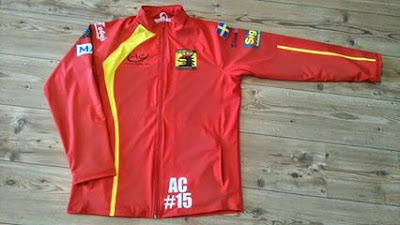Except for sight-seeing and any rugby shots that make me look like I have any ability at all...
This weekend was my tour with the Skåne Old Boys team to Romania.
First up was our special tour gear:
 |
| The jacket |
 |
| The polo shirt |
 |
| Training shirt |
 |
| Playing kit |
We flew out on Friday at 10:30am for a two hour flight to Romania from Malmö airport. When we landed we caught a taxi to the Bucharest Mercure hotel and settled in, had a couple of drinks and headed out to dinner with the Romanian Draculas team.
The currency of Romania is the Lei - 1 Lei was about 30 Australian cents, or 2 Swedish Kronor. The taxi ride from the airport to the hotel with 4 people in the cab cost us 17 Lei (about AU$6 or 40kr).
The scenery from the taxi was interesting - Bucharest had an odd mix of buildings, some communist era cement blocks and some with ornate carvings. Some of the buildings were big and well tended and others were very run down.
-----------------------
Brief history:
In the middle ages, Romania consisted of Wallachia, Moldavia and Transylvania. In the 14th century Wallachia and Moldavia combined to fight against to Ottoman empire, but by 1541 all three regions were under Ottoman control as a 'suzerainty' (a tributary vassal state with subservient autonomy). There were several revolutions against the Ottomans in the 1800s and in 1877 Romania allied with Russia in the Russo-Turkish war. After the war, Romania was recognized as an independent state.
In World War I, Romania remained neutral for several years, but eventually joined the Russians, French and United Kingdom against Germany and Austria-Hungary. This didn't work out well for Romania and the country was two-thirds occupied by 1917. After Russia withdrew from the war, Romania was left isolated and negotiated a ceasefire. It was fully occupied in May 1918 and subject to some harsh sanctions.
Romania tried to remain neutral during World War II, however the Russians threatened to invade unless Romania yielded land, including parts of Moldavia. The Germans negotiated with Romania, offering them Moldavia back if they assisted in the war effort, however the Germans also negotiated with the Russians, promising them Moldavia. Romania joined the Axis powers and contributed large numbers of men to the war as well as large reserves of oil. The allies bombed Romania regularly to try to stop the oil supply and the Romanian people became unhappy, eventually undergoing a coup and switching sides to the Allies. This removed the third largest supply of oil to the Axis and possible assisted in hastening the ending of the war.
After the war the Soviets occupied Romania and a communist government ran the country after a fraudulent election and King Michael I was forced to abdicate and was exiled. In 1965 the communist leader was Nicolae Ceaușescu who was not popular. After a visit to Pyongyang he began building a massive palace in the image of the North Korean capital. He was overthrown in 1989 and executed along with his wife, before the palace could be finished.
Romania then converted to democracy and has since joined NATO and become a member of the EU.
The capital, Bucharest, was not located in the best location - being in an open plain with little natural defenses. It was often attacked and few of the original buildings remain (mostly churches).
-----------------------------
This history explained many of the buildings we were seeing. The solid, blocky communist flats sat next to old pre-communist ornately carved buildings, next to incomplete or run-down ruins. It made for a very interesting city, that was in parts very beautiful and in others slightly sad, with hints of a troubled past.
 |
| On the way to Bucharest Mercure hotel |
 |
| There was lots of graffiti |
After we left the hotel we headed to dinner and beer and Pálinka (a plum brandy).
 |
| Beer and Pálinka |
Anyone who has known me for a while, knows that I don't usually drink beer. Of course, when on tour and the beer is free (or cheap - AUD$2 for a large stein) rules can always be bent...
The entertainment was some traditional Romania music, including a violinist and Romanian dancing and lots of beer. The food was great, we started with a cheese and cold cuts plate, followed by
Sarmale (cabbage rolls) and polenta. The company was great and it was a fun night. Near the end of the night, small plates were bought out and we expected a small dessert, however huge plates of meat were brought out - grilled chicken, pork and beef.
 |
| The meat tray |
No comments:
Post a Comment